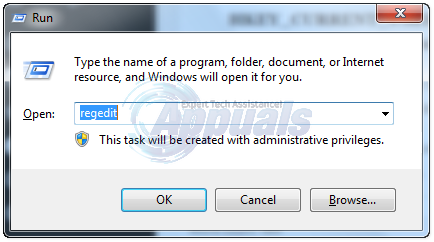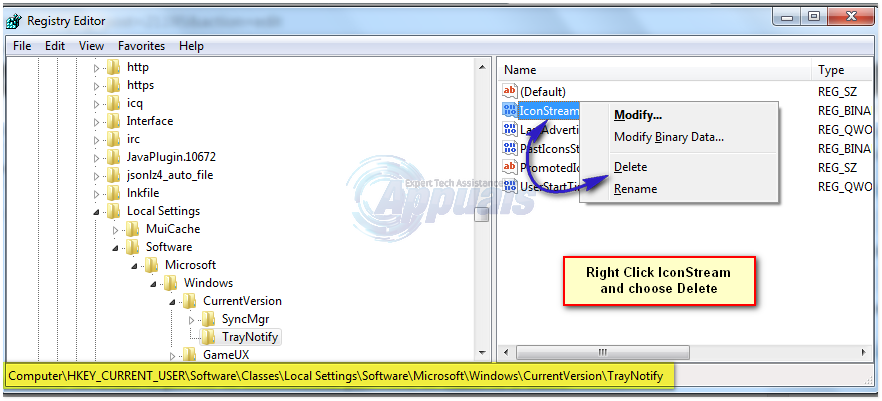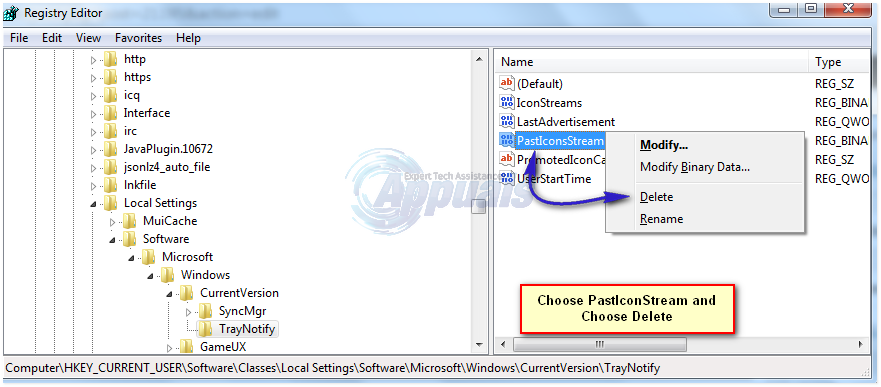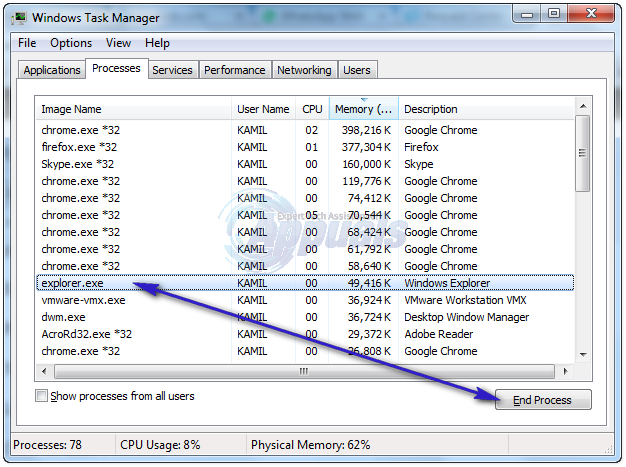However, these system icons – especially the Volume and Network icons – have a tendency to go missing from their places in the Notification Area/System Tray. This little tendency turns into an extremely aggravating and significant issue, an issue that first came to the attention of Windows users across the globe back in the days of Windows Vista. This problem would also go on to affect Windows Vista’s successor, Windows 7, and the iterations of the Windows OS that came after it. Users affected by this issue sometimes experience temporary relief when they restart their computers and find that the missing system icons have returned to their rightful places, but this relief is mostly temporary as one or more system icons go missing again after some time. Thankfully, this problem is just as permanently fixable as it is troublesome, and the following are some of the most effective solutions that can be used to resolve it:
Solution 1: Restore the missing system icons using the Registry Editor
The most effective and most popular solution to this problem is restoring the missing system icons by performing a few tweaks in an affected user’s computer’s registry through a built-in Windows utility known as the Registry Editor. If you want to fix this issue using this method, you need to: Press Windows Logo key + R to open a Run Type regedit into the Run dialog and press Enter to launch the Registry EditorIf asked to confirm the action or provide an administrator password, do whatever is asked. In the left pane of the Registry Editor, navigate to the following directory: In the right pane of the Registry Editor, locate and right-click on an entry named IconStreams, click on Delete in the contextual menu and click on Yes in the consequent popup.
Next, locate and right-click on an entry named PastIconsStream, click on Delete in the contextual menu and click on Yes in the consequent popup.
Note: If you do not see the TrayNotify subfolder under CurrentVersion in the right pane of the Registry Editor (which is a rare instance), press Ctrl + F to initiate a search of your entire registry. Leave everything in the consequently opened Find dialog as it is, type IconStreams into the Find what field and click on Find Next. Allow your registry to be searched, and once the process is complete, you will be taken to the location of the IconStreams registry entry. The PastIconsStream registry entry will be in the same location, and you can then go on to delete both of them. Exit the Registry Editor. Press Ctrl + Shift + Esc to launch the Task Manager. Navigate to the Processes Locate, click on and select the process named explorer.exe. Click on End Process
Click on File in the toolbar at the top. Click on New Task (Run…). Type explorer into the dialog and press Enter. Exit the Task Manager. You should now see the missing system icons back in their rightful places.
Solution 2: Use a Microsoft Fix-It designed specifically to fix this problem
As stated before, the registry is an incredibly fragile part of any Windows computer. That being the case, most people would not want to fiddle around with their registry and would rather not use a fix to a problem that involves manually editing the registry. If you are one of those people, fear not as there is a much safer solution to this issue, one which you can use to solve this problem through the Registry Editor without even having to open the Registry Editor! How will you accomplish such a task, you ask? Well, all you need to do is click here, click on Download under the Fix it for me section of the Microsoft article to begin the download of a Microsoft Fix-It that has been created specifically to fix this issue and, once the Fix-It has been downloaded, navigate to and double-click on it to launch it. Once the Microsoft Fix-It has been launched, follow the onscreen instructions it will perform the necessary tweaks to your computer’s registry for you so you do not have to mess around with your registry, making the entire process basically risk-free.
Solution 3: Perform a System Restore
If you have any System Restore Points that were created before you started experiencing this issue, you may be able to fix it by performing a System Restore. A System Restore resets your computer to a previously saved point in time, although none of the data saved on your computer is affected. Performing a System Restore does uninstall any programs, applications, drivers and updates that were installed after the creation of the selected System Restore Point. To perform a System Restore, you need to: Hold the Windows Key and Press R. Type rstrui.exe in the run dialog, and click OK. When the System Restore program launches, click on Choose a different restore point and click on Next. Click on and select a System Restore Point that was created before you started suffering from this problem. Click on Next. Once the System Restore has been performed successfully, click on Finish.
Restart your computer, and if the solution worked, you will see all of your missing system icons back where they belong once your computer boots up.
Some Taskbar Icons Are Missing from Windows 11’s Taskbar? Here’s How to Fix ItFix: Windows 10 Taskbar Icons MissingHow to Fix Taskbar Icons Missing After Reboot on Windows 11Fix: Exe files not opening on Windows 7 or Vista



